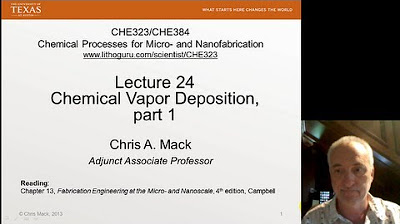Physical Vapour Deposition - Detailed Explanation
Summary
TLDRThis video explores various deposition processes in material science, including Chemical Vapor Deposition (CVD), Physical Vapor Deposition (PVD), and other techniques. It covers their applications in industries like electronics, aerospace, and semiconductors. The script also emphasizes the difference between physical and chemical deposition methods, explaining how materials are deposited onto surfaces through physical or chemical reactions. Viewers are encouraged to subscribe for more detailed content, with the video combining technical education with an interactive YouTube-style presentation.
Takeaways
- 😀 Deposition techniques are crucial in material science and engineering, particularly for applying thin films and coatings to various materials.
- 😀 Chemical Vapor Deposition (CVD) is highlighted as a key method for depositing thin films in semiconductor and electronics industries.
- 😀 Electron Beam Deposition is another method mentioned for depositing high-quality films, commonly used under vacuum conditions.
- 😀 There is a focus on the importance of temperature control, vacuum environments, and material properties during deposition processes.
- 😀 The script emphasizes the need for proper understanding of the physical and chemical processes involved in deposition.
- 😀 Various types of deposition techniques are discussed, including liquid spraying and electroplating, with comparisons between their applications.
- 😀 The process of deposition can vary greatly depending on whether the technique is physical (e.g., electron beam deposition) or chemical (e.g., CVD).
- 😀 Calls to action for subscribing to the channel appear repeatedly throughout the video to engage viewers and increase subscriptions.
- 😀 The script includes references to specific applications of deposition processes in industries like semiconductors, electronics, and materials engineering.
- 😀 The video content aims to provide both theoretical knowledge and practical insights into deposition technologies, ideal for a technical audience.
Q & A
What are the different types of deposition processes mentioned in the script?
-The script mentions several deposition techniques, including Physical Vapor Deposition (PVD), Chemical Vapor Deposition (CVD), and Electron Beam Deposition.
What is the basic principle behind Physical Vapor Deposition (PVD)?
-PVD involves vaporizing a material in a vacuum chamber, which then condenses onto a substrate to form a thin film. This is used for coating surfaces with materials like metals and ceramics.
How does Chemical Vapor Deposition (CVD) work?
-CVD involves the chemical reaction of gaseous compounds that results in the formation of a solid material, which is then deposited on a substrate. It is widely used in the semiconductor and solar panel industries.
What is the role of electron beam deposition in material science?
-Electron Beam Deposition uses a high-energy electron beam to vaporize material in a vacuum. The vapor then condenses onto a substrate, allowing precise deposition of materials for high-quality coatings, commonly used in advanced electronics.
Why is vacuum important in deposition processes?
-A vacuum is important in deposition processes because it reduces the interaction of vaporized material with air, ensuring cleaner, more controlled deposition and avoiding contamination.
What is the significance of temperature control in deposition processes?
-Temperature control is crucial in deposition processes because it affects the rate of deposition, the quality of the deposited layer, and the material's properties. High temperatures can influence the rate of evaporation and condensation.
Can you explain the difference between PVD and CVD deposition techniques?
-The key difference is that in PVD, material is vaporized and deposited onto a substrate, whereas in CVD, chemical reactions in gases create a solid material that is deposited. PVD is generally used for metallic coatings, while CVD is used for semiconductor and thin-film applications.
What are the applications of deposition processes in the real world?
-Deposition processes are widely used in creating thin films for electronics, coatings for tools and machinery, semiconductors, solar panels, and even optical devices. These technologies are fundamental in high-tech manufacturing.
What is the benefit of using Electron Beam Deposition over other methods?
-Electron Beam Deposition offers high precision and control over material deposition, making it ideal for applications requiring extremely fine and uniform coatings, such as in semiconductor fabrication.
Why is subscribing to the channel encouraged in the script?
-Subscribing to the channel is encouraged as it helps viewers stay updated on future videos, which will cover advanced topics in deposition techniques, material science, and other related technologies.
Outlines

This section is available to paid users only. Please upgrade to access this part.
Upgrade NowMindmap

This section is available to paid users only. Please upgrade to access this part.
Upgrade NowKeywords

This section is available to paid users only. Please upgrade to access this part.
Upgrade NowHighlights

This section is available to paid users only. Please upgrade to access this part.
Upgrade NowTranscripts

This section is available to paid users only. Please upgrade to access this part.
Upgrade Now5.0 / 5 (0 votes)





